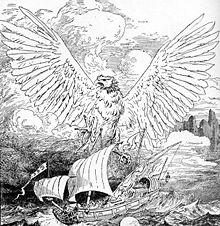Saran Roc
 | |
| An animal is a human with bad breath and an appetite for evil. | |
| Kingdom: | Animalia |
| Genus: | Morbidavis |
| Species: | Morbidavis
|
| Geographic Spread: | Mar Sara |
| Conservation Status: | Okay |
| Mythological: | No |
| Magical: | No |
The Saran Roc is a species of bird native to the island. It has been given many names by Matbaic, Saran and Shirerithian groups; its Antican scientific name is Morbidavis morbidavis. It is noteworthy for being the only known species of bird on Micras to display eusocial characteristics, in a manner not dissimilar from that expressed in certain mammalian populations but best known in its purest form among ants, termites, bees and wasps.
Physical description
The roc is a feathered bird, with black skin and plumage, though some variation (white speckles for example) have been reported. They have long, straight beaks and talons used for a variety of purposes. Their eyesight and hearing are exceptional and they are capable of long flight.
Among a single wake of roc (their proper term of venery), different members exhibit different physical characteristics, though they remain one unified species. This difference in physical size and other characteristics is attributable to differences in diet from birth in a caste system which is firmly and instinctually carried on across generations. There are three main physical categories of roc, each associated with a particular role in wake life:
- Reproductive roc: The queen and her male consorts - numbered 1-3 depending on the size of the wake - are the largest birds in the wake. Their wingspan can reach up to 5.5m; body length is around 1.3m.
- Warrior roc: A number of roc guard the nest and worker roc as they perform their functions. These are slightly smaller than the queen and consorts - 3.8m wingspan, 1m body length.
- Worker roc: The smallest and most numerous caste, workers are much smaller at 2m wingspan and 0.7-0.8m body length.
Though these three castes see very little intermigration between them even well before the birds reach adulthood, the difference is not genetic. All birds in a wake are born of the same mother, though potentially different fathers. It was originally believed that all three castes were in fact separate species - Morbidavis terrificus, Morbidavis canis and Morbidavis servitor respectively - but once nests were actually observed in the wild, it became clear that none except the queen were breeding and that smaller roc were in fact living in close association with the larger birds. The most pervasive belief was that while the reproductive and warrior castes were acknowledged as one species, the workers simply could not be, but this has been disproved.
Eggs are selected and categorised by workers attending the queen, on an unclear basis. It has been suggested that the healthiest and largest of eggs may be selected for reproductive and warrior caste status - which from hatching and even before involves more attention and nutrition - but the few studies that have been undertaken to prove this empirically have not yielded significantly conclusive results.
Behaviour and eusociality
The caste responsibilities describes above are generally observed rigidly by their members. The queen produces children regularly, though not constantly as in many eusocial species. The central features of eusociality are clearly shown in the Saran roc - a division of labour, ecological contributions, kin selection, a lack of divisions between generations.
In times of emergency - following an attack on the wake, or during a scarcity of good - warriors become flexible. During droughts they are known to undertake hunting responsibilities, and this, contributed to by the lack of smaller mammals, leads to the reports of humans being attacked and hunted by Saran roc. They may even perform the functions of consort or queen. This means however that in certain circumstances they are targets of hostility from the reproductive caste. Hostility to rival queens is ingrained in all castes, and female warriors are most likely to cut this fatal figure. Where however the queen is mortally wounded, the largest and most senior (fertile) female warrior will often happily take on her new post until a new queen hatchling arrives.
Saran roc generally feed on animals and insects of varying sizes - from lambs to lizards. As mentioned above, larger animals such as humans or bovines are targeted in the event of famine; it has also been known for some wakes to take to the oceans and rivers, with limited success, to catch fish.
In accordance with their varying sizes, roc live to different ages. The queen and consorts may live up to 100-120 years without predation or human hunting; the warriors, around 60-70 years, and the workers varying between 15-30 years. As long as prey is plenty, wakes may remain in the same area and frequent the same hunting grounds for generations of queens.
Distribution and conservation status
The Saran roc were never known to be plentiful, and their longevity as a species is attributed to their eusociality, which allows individual birds to expend their energies in favour of the greater good of the wake, following their instincts as animals in such a close relationship from birth. As a species their Shirerithian Conservation Status is "Okay" (colour code Sea green), although they have been hunted more significantly in the North and populations there are dwindling. They generally flourish away from human settlements in the Tyrelian mountains and near Mar Sara's coasts.
Cultural and religious significance
To the Kop'mar, the roc have long been regarded as a representation or the degenerated cousins of the legendary dragons commanded by one of their three gods, Shala. They are therefore revered as semi-divine manifestations, studied as graceful animals and depicted in various media as beautiful and majestic creatures.
The reaction of Shirerithian settlers to the Saran roc was quite the usual response to large and mysterious birds of prey in foreign lands - avoid, unless you have to eat them. And in this way a small and short-lived heretical schism from the Cult of B'caww, God of Spicy Chicken, was discovered. It began thus. An Anthology of Saran Tales wrote:
During the reign of Count Thomas IV, when Carol reigned in Shirekeep, an adherent of the Spiced Poultry God found himself traversing the freezing peaks of the Tyrelj, alone. He was sure to die, as his companions had; he had no food, no hope for survival, and would not survive the night. He used his last energy to offer a traditional prayer to B'caww; as he murmured the sacred verses, a full and plump Saran roc worker fell down dead in front of him. He feared it might be diseased and did not look forward to his last meal being raw deceased bird. Just then he caught sight of a cave, and went inside, and in there he found a roaring flame unattended. He took this to be a holy miracle and so he gave thanks to B'caww for saving him, and decided to use the vial of twelve holy spices which all spiciples keep around their necks on the meal provided for him. It was so delicious that the man, Burnip Crae, saw the light that B'caww's true intention was for his followers not to eat chicken but spicy roc.
-An Anthology of Saran Tales
Crae's heresy lasted twenty five years before the Shirerithian authorities arrested and burned him. In an ironic twist, rocs feasted on his chargrilled corpse, and apparently he was delicious.
The Matbaic clergy, on discovering the majestic roc, were highly taken of their feathers. Looking at their clergy vestments reveals that Matbaic Orthodoxy requires a lot of black for monks, abbots, deacons and bishops. Therefore hunting Saran roc became a frequent hunting expedition for their settlers; peasants were paid well, by the feather unmarked and in good condition. As well as keeping the wearer dry, roc feathers are incredibly smooth and soft to the touch, and were and are highly prized by high-ranking and wealthy ecclesiastics. It remains a tradition to this day for the holders of various ancient Matbaic estates - including Suryo Wardo and Castle Sourenian - as well as the Mayors of the cities of Yaad and Sulay to present to the Bishop of Suryo an annual tithe of a talon of a Saran roc, which are gilt and used for the final turn of his crozier.

